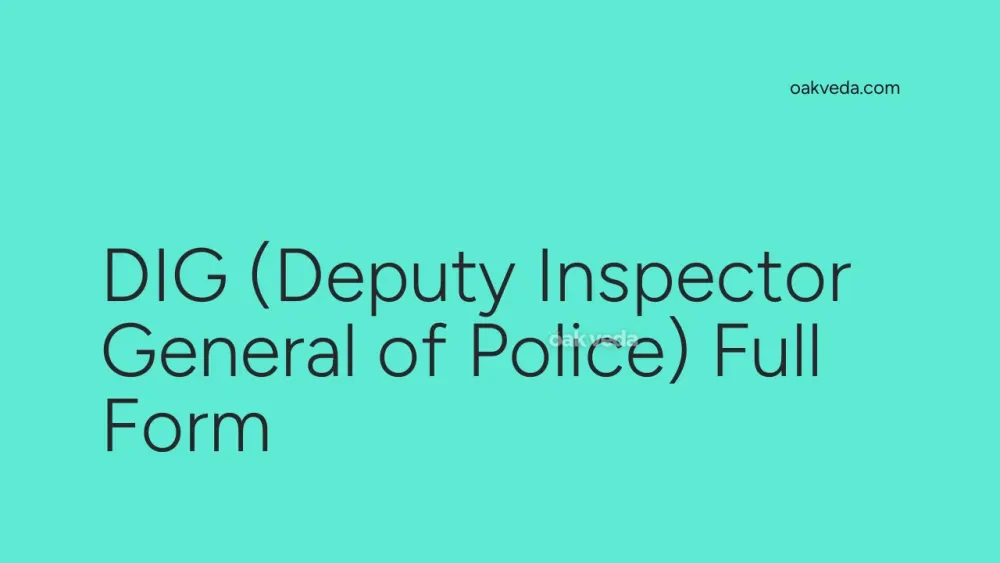
What is the Full Form of DIG?
The full form of DIG is Deputy Inspector General of Police. This high-ranking position in the police force plays a crucial role in maintaining law and order, supervising police operations, and ensuring effective policing across various jurisdictions.
What is Deputy Inspector General of Police?
The Deputy Inspector General of Police is a senior-level position within the police hierarchy, typically ranking above Superintendents of Police (SP) and below the Inspector General of Police (IGP). DIGs are responsible for overseeing multiple police districts or specialized units, ensuring smooth operations, and implementing policing strategies.
Origin and Development of Deputy Inspector General of Police
The position of Deputy Inspector General of Police has its roots in the colonial-era police system in India. As the police force evolved and expanded, the need for intermediate ranks between the Inspector General and district-level officers became apparent. The DIG role was established to bridge this gap and provide more effective supervision and coordination of police activities.
How does the DIG Role Work?
A DIG typically oversees a range of responsibilities:
- Supervision: Monitoring and guiding the work of Superintendents of Police and other subordinate officers
- Policy Implementation: Ensuring that policing policies and directives are properly executed at the ground level
- Coordination: Facilitating cooperation between different police units and districts
- Resource Management: Overseeing the allocation and utilization of personnel and resources
- Quality Control: Maintaining high standards of policing and addressing any issues or complaints
Functions of Deputy Inspector General of Police
The primary functions of a DIG include:
- Conducting regular inspections of police stations and units
- Reviewing and analyzing crime statistics and trends
- Developing and implementing crime prevention strategies
- Ensuring proper investigation of serious crimes
- Coordinating with other law enforcement agencies and government departments
- Handling disciplinary matters within the force
- Providing guidance and mentorship to junior officers
Applications of the DIG Role
The DIG position finds application in various aspects of law enforcement:
- Range DIGs: Oversee multiple districts within a specific geographical range
- Specialized Unit DIGs: Lead specialized branches such as crime investigation, intelligence, or traffic
- Training DIGs: Manage police training institutions and programs
- Administrative DIGs: Handle personnel, logistics, and other administrative functions
Features of the Deputy Inspector General of Police Position
Key features of the DIG role include:
- Strategic Leadership: DIGs play a crucial role in shaping policing strategies and policies
- Operational Oversight: They ensure effective implementation of policing plans and tactics
- Intermediary Role: DIGs act as a bridge between top-level police leadership and ground-level operations
- Career Progression: The position is an important step in the career path of senior police officers
Benefits of the DIG Position in Law Enforcement
The DIG role offers several benefits to the police force and society:
- Improved coordination and supervision of police activities
- Enhanced accountability within the police hierarchy
- More effective implementation of policing strategies
- Better resource allocation and management
- Improved mentorship and guidance for junior officers
Limitations or Challenges of the DIG Role
Despite its importance, the DIG position faces certain challenges:
- Balancing administrative duties with operational responsibilities
- Managing diverse teams across multiple districts or units
- Adapting to rapidly changing law enforcement technologies and methodologies
- Addressing public expectations and maintaining community trust
- Navigating political pressures and bureaucratic hurdles
Future Developments in the DIG Role
As law enforcement continues to evolve, the DIG role is likely to see several developments:
- Increased focus on technology-driven policing strategies
- Greater emphasis on community-oriented policing and public relations
- Enhanced training in cybercrime and digital forensics
- More collaborative approaches with international law enforcement agencies
- Adaptation to emerging challenges such as terrorism and organized crime
FAQs on DIG Full Form
-
How does one become a DIG in India? There are two primary paths to becoming a DIG in India:
- Direct recruitment through the Civil Services Examination conducted by the Union Public Service Commission (UPSC)
- Promotion from the State Police Service after years of service and meeting specific criteria
-
What is the difference between a DIG and an IGP? A DIG (Deputy Inspector General) is junior to an IGP (Inspector General of Police). While a DIG typically oversees multiple districts or specialized units, an IGP has broader responsibilities, often at the state or national level.
-
How long does it take to become a DIG? For direct recruits entering through the IPS, it typically takes about 14-16 years of service to reach the DIG rank, depending on vacancies and performance.
-
What comes after the DIG rank? After DIG, the next rank in the police hierarchy is usually Inspector General of Police (IGP), followed by Additional Director General of Police (ADGP) and Director General of Police (DGP).
-
Do all states in India have DIGs? Yes, the DIG rank exists in all states of India, although the exact structure and number of DIGs may vary depending on the state's size and policing needs.
In conclusion, the Deputy Inspector General of Police (DIG) plays a vital role in India's law enforcement system. As a senior-ranking officer, the DIG bridges the gap between top-level leadership and ground operations, ensuring effective policing across various jurisdictions. Understanding the full form and functions of this crucial position helps in appreciating the complex structure of law enforcement and the dedicated individuals who serve to maintain law and order in society.
You may be interested in:

